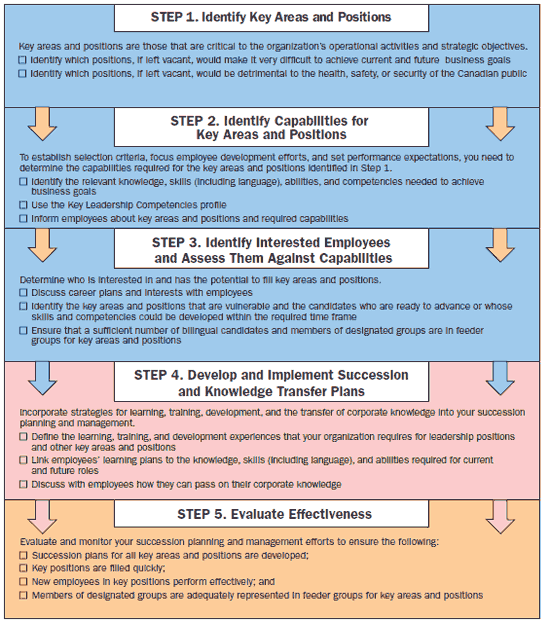Succession Planning and Management Five-Step Process
Succession planning and management is an essential component of the broader human resources planning process. It involves an integrated, systematic approach for identifying, developing, and retaining capable and skilled employees in line with current and projected business objectives.

Textual version
STEP 1. Identify Key Areas and Positions
Key areas and positions are those that are critical to the organization's operational activities and strategic objectives.
- Identify which positions, if left vacant, would make it very difficult to achieve current and future business goals
- Identify which positions, if left vacant, would be detrimental to the health, safety, or security of the Canadian public
STEP 2. Identify Capabilities for Key Areas and Positions
To establish selection criteria, focus employee development efforts, and set performance expectations, you need to determine the capabilities required for the key areas and positions identified in Step 1.
- Identify the relevant knowledge, skills (including language), abilities, and competencies needed to achievebusiness goals
- Use the Key Leadership Competencies profile
- Inform employees about key areas and positions and required capabilities
STEP 3. Identify Interested Employees and Assess Them Against Capabilities
Determine who is interested in and has the potential to fill key areas and positions.
- Discuss career plans and interests with employees
- Identify the key areas and positions that are vulnerable and the candidates who are ready to advance or whose skills and competencies could be developed within the required time frame
- Ensure that a sufficient number of bilingual candidates and members of designated groups are in feeder groups for key areas and positions
STEP 4. Develop and Implement Succession and Knowledge Transfer Plans
Incorporate strategies for learning, training, development, and the transfer of corporate knowledge into your succession planning and management.
- Define the learning, training, and development experiences that your organization requires for leadership positions and other key areas and positions
- Link employees' learning plans to the knowledge, skills (including language), and abilities required for current and future roles
- Discuss with employees how they can pass on their corporate knowledge
STEP 5. Evaluate Effectiveness
Evaluate and monitor your succession planning and management efforts to ensure the following:
- Succession plans for all key areas and positions are developed;
- Key positions are filled quickly;
- New employees in key positions perform effectively; and
- Members of designated groups are adequately represented in feeder groups for key areas and positions
- Date modified: